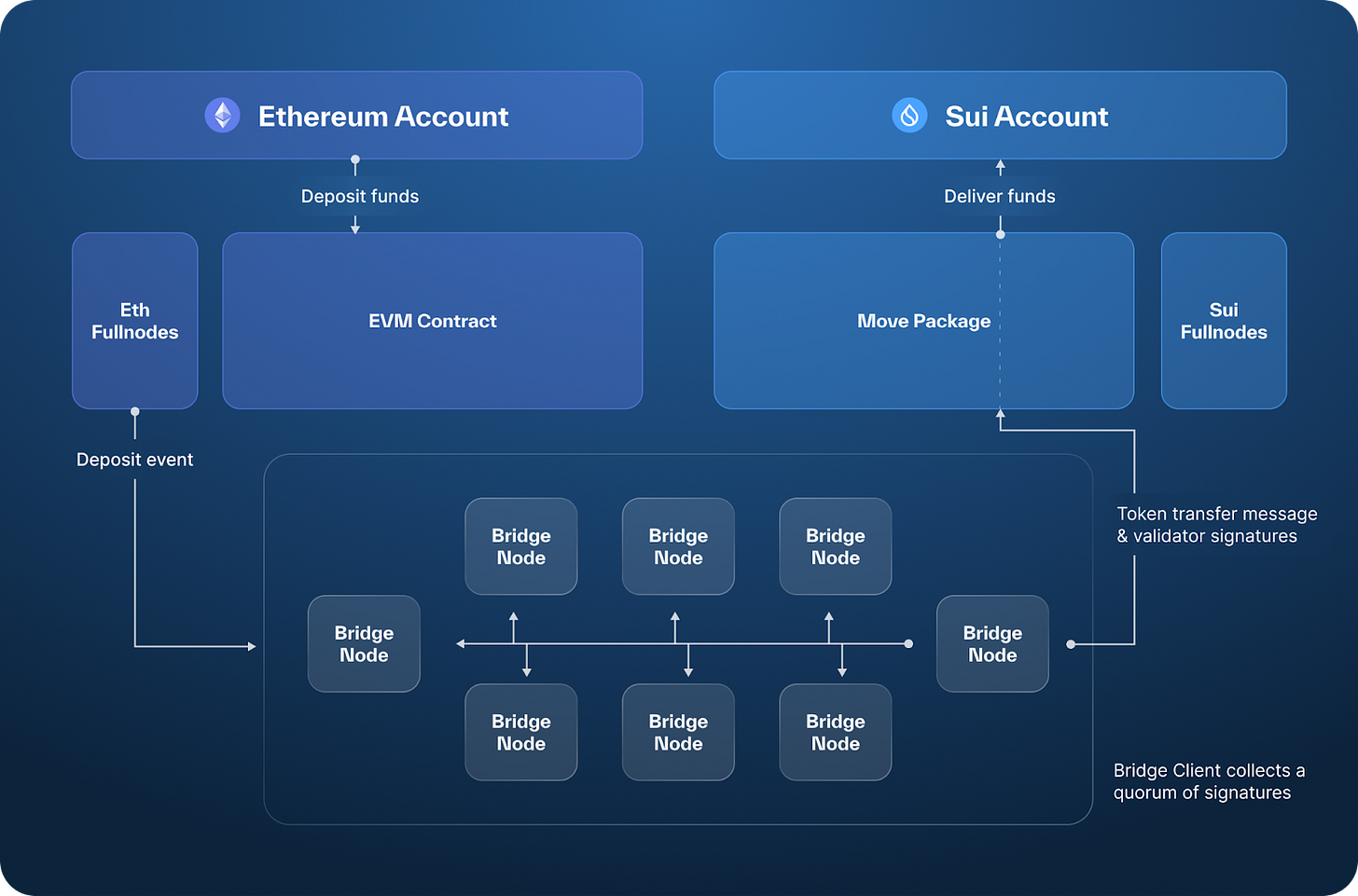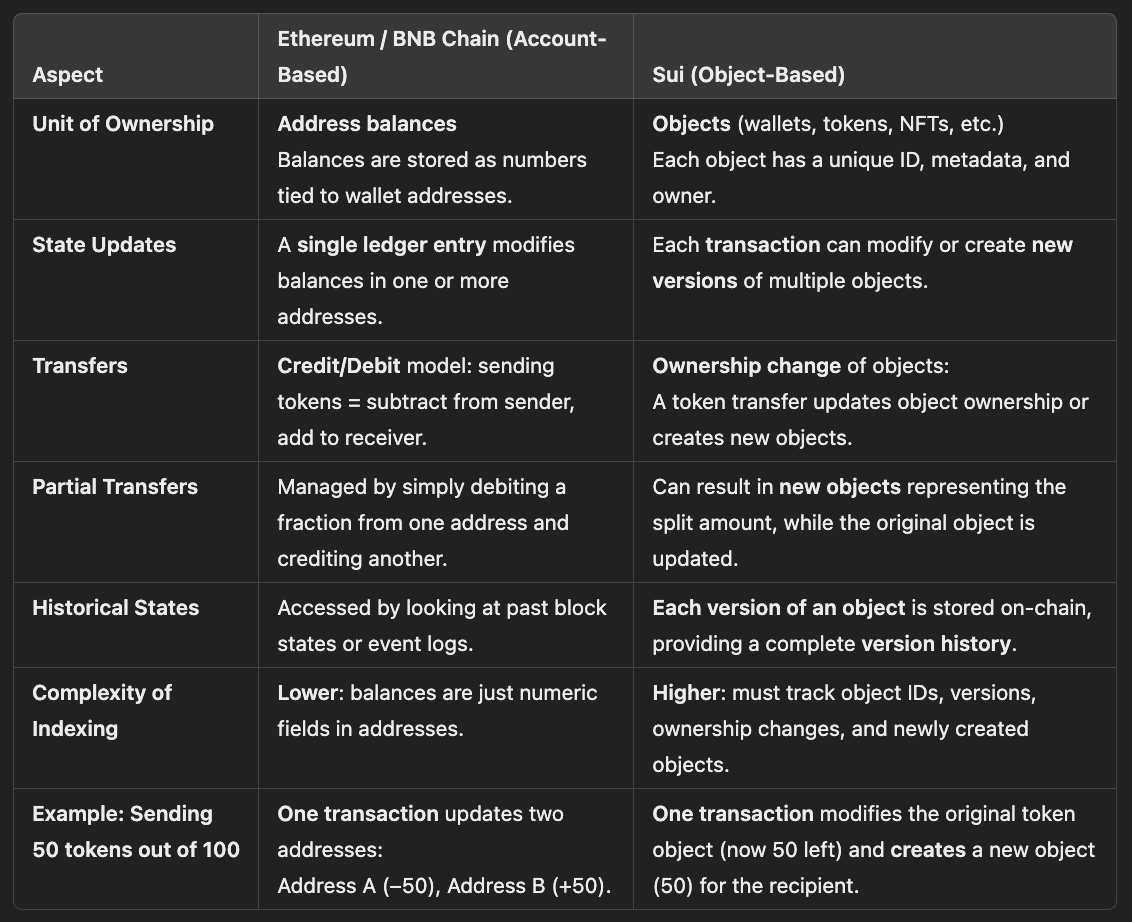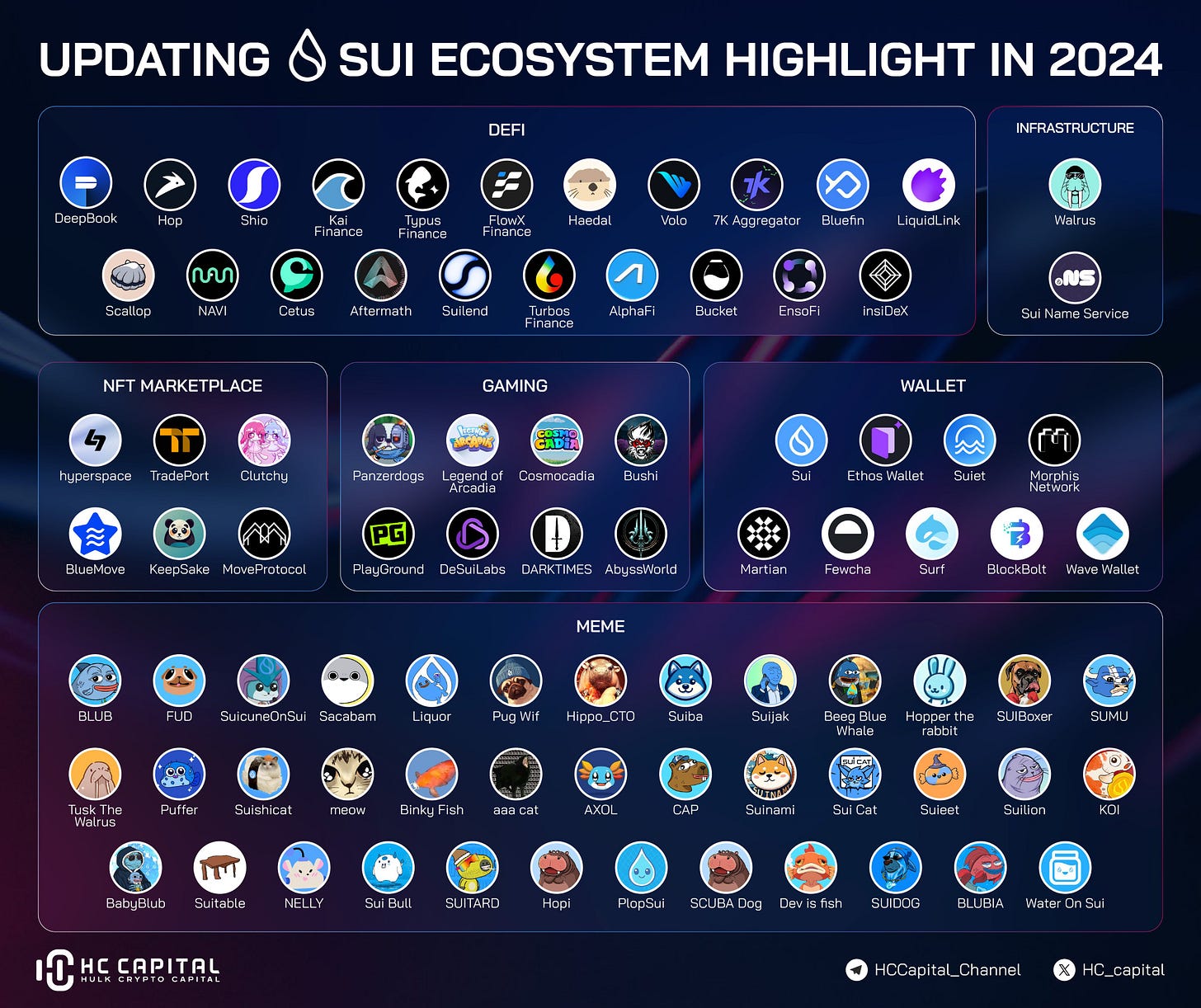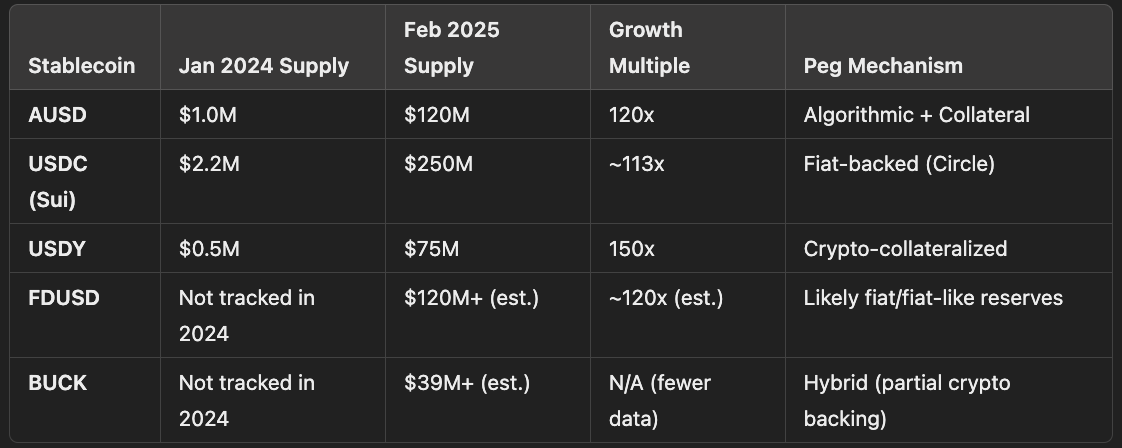Stablecoin supply on Sui has surged nearly 100x, from $5.4M to $490M in just over a year—one of the fastest expansions in Web3.
With 1.7M+ daily active users, Sui is outpacing Ethereum’s growth rate and rivaling Aptos, driven by high-speed DeFi, institutional adoption, and aggressive liquidity incentives.
As capital inflows accelerate, is Sui positioning itself as the next dominant blockchain for stable digital assets? Let’s break it down. 👇
Table of Content
Introduction
Overview of Sui’s Object-Based Model
SZNS’s Indexing Solution
Growth Trajectory and Ecosystem Composition
Deep Dive into Major Native Stablecoins
Stablecoin Supply Growth & Use Cases
Stablecoin Liquidity in Sui DeFi
Holder Distribution and Concentration
Beyond DeFi: Real-World Use Cases
Comparative Analysis: Sui vs. Other L1 Blockchains
Conclusion
1. Introduction
Since its inception in 2022 by former Meta engineers, Sui has evolved into a high-throughput, low-latency Layer 1 blockchain that prioritizes scalability, low fees, and user-centric design.
Its backbone—a next-generation Mysticeti consensus derived from Narwhal (mempool) and Tusk (consensus)—enables efficient transaction ordering and robust data availability. Sui has garnered significant attention from both institutional investors and the DeFi community.
With new protocols launching monthly and user bases expanding through DeFi, gaming, and digital payments, stablecoins have emerged as a core financial primitive within the ecosystem.
Key Highlights
Market Cap (Sui stablecoins): Grown from $5.42M (Jan 2024) to $555.15M (Feb 2025).
Stablecoin Adoption: Features 5+ major tokens (native & bridged), with native stablecoins accounting for 80.1% of total supply on Sui.
Ecosystem Growth: Hackathons, developer grants, and a pipeline of gaming and payments projects underscore Sui’s broader ambitions.
2. Overview of Sui’s Object-Based Model
2.1 Conceptual Difference from Account-Based Systems
In typical blockchains like Ethereum or BNB Chain, each account holds a static balance updated by a ledger-based credit/debit system. In contrast, Sui uses an object-based model where every item—user wallet, token, NFT—exists as an object with distinct attributes and ownership. Key implications for stablecoins include:
Object Versioning: Every transaction creates a new version of the affected object(s), preserving a full audit trail of state changes.
Complex Transfers: Partial transfers can result in the creation of new objects (representing the moved fraction) while updating the original object’s balance.
Ownership Shifts: Transfer of a stablecoin implies transferring ownership of an object (or a newly created sub-object), rather than updating a single “balance” field.
These principles underpin the flexibility and scalability Sui is known for, but they also necessitate advanced indexing to accurately track stablecoin supply, distributions, and historical balances.
How Object Versioning and Partial Transfers Work in Sui
Below is a conceptual diagram of how a partial transfer of stablecoins (or any Sui-based token) creates new object versions and ownership changes.
Original Object (Object0):
Has a balance of 100 tokens (e.g., stablecoins).
Owned by Alice (represented internally by an owner field in the object).
Partial Transfer of 30 Tokens:
Instead of merely subtracting 30 from Alice’s balance and crediting Bob, Sui modifies Object0 to reduce its balance to 70 and creates a new object (ObjectX) with a balance of 30.
Ownership of ObjectX is assigned to Bob, while Object0 remains with Alice (now at a new version, Object0*).
Versioning:
Object0* is the updated version of the original token object (version 2), while ObjectX is a fresh object.
The old version of Object0 remains in historical storage for auditability, but its state is “superseded” by Object0*.
2.2 SZNS’s Indexing Solution
SZNS is a data solutions provider that specializes in handling the unique object-based structure of the Sui blockchain. Unlike traditional account-based blockchains where balances are stored in a single ledger entry, Sui represents assets as objects, meaning each transaction updates and creates a new version of an object rather than simply changing a wallet’s balance.
This object-centric model creates a fundamental challenge for tracking and aggregating stablecoin balances, as stablecoin supply and liquidity are not neatly stored in a single contract but instead distributed across multiple object states. SZNS addresses these challenges by reconstructing token balances dynamically and indexing liquidity across various DeFi protocols on Sui.
At a high-level overview, SZNS addresses these challenges through a multi-layered approach:
Object-Level Balance Reconstruction
Scans for all objects associated with a wallet and retains only the latest versions for real-time balance visibility.
Past states and older versions are archived for historical queries (e.g., to see balances at specific block heights).
Unified DeFi Liquidity Mapping
Identifies custom DeFi structures like pool objects, lending receipts, or escrow contracts.
Normalizes attributes (reserves, LP shares, fees) into a standard internal data model, making it simpler to compare liquidity across multiple protocols.
Exception Handling
Supports unusual cases such as locked (vesting) or delegated (staking) stablecoins.
Incorporates specialized logic for protocols with non-standard object structures, ensuring minimal data loss.
By aggregating data from these indexing pipelines, SZNS can reliably present up-to-date stablecoin metrics—critical for understanding the ecosystem’s liquidity flows and user behaviors.
Step-by-Step Explanation
Data Ingestion
SZNS continuously monitors the Sui blockchain for new transactions, block data, and state changes.
Relevant information (e.g., object creation, ownership changes, updated balances) is pulled into the indexer.
Object-Level Scanner (Balance Reconstruction)
The indexer queries all objects owned by each wallet.
Only the latest version for each object ID is retained in the “real-time” index.
Older versions of each object are archived for historical lookups or forensic analysis (e.g., to see a wallet’s balance at a specific block number or date).
DeFi Liquidity Mapper
Identifies protocol-specific object types related to DeFi:
Pool objects for DEXs.
Lending receipts for borrowing/lending platforms.
Escrow contracts for specific yield farms or IDO platforms.
Normalizes data into a standard internal model so that disparate DeFi protocols can be compared side-by-side.
For example, “pool reserves” might be stored differently on two DEXs, but SZNS standardizes them as
[tokenA_reserve, tokenB_reserve].
Exception Handler
Locked or vesting tokens that cannot be transferred until a future date.
Delegated or staked tokens in specialized contracts or staking modules.
Any protocol-specific quirks (e.g., “rebasing” stablecoins, partially collateralized structures).
These exceptions are flagged and classified properly so they don’t inflate or misrepresent a user’s tradable stablecoin balance.
Final Aggregation & API
Data from the previous steps is aggregated into a single repository.
End-users (wallet explorers, analytics dashboards, DeFi applications) can query SZNS’s API to get:
Real-time stablecoin balances.
Liquidity across DEXs, lending pools, and yield farms.
Historical states (e.g., user’s balance on a particular date).
3. Growth Trajectory and Ecosystem Composition
Market Capitalization Trends
From $5.42M to $555.15M in a little over a year, the total market capitalization of stablecoins on Sui underscores robust ecosystem growth.
This growth is an indicator of Sui’s technical advantages and user-friendly design:
Scalability: High throughput and low finality times make Sui an ideal platform for stablecoin issuers seeking frictionless user experiences.
Institutional Confidence: Funds like VanEck and other large capital allocators have cited Sui’s performance metrics favorably.
Diverse Use Cases: Beyond DeFi, stablecoins on Sui are gaining traction in gaming, cross-border payments, and NFT marketplaces.
4. Deep Dive into Major Native Stablecoins
Sui ranked 7th above Hyperliquid, Avalanche in the 24hr volume
From $5.4M to $490M in a little over a year, the total market capitalization of stablecoins on Sui underscores robust ecosystem growth.
Sui’s ecosystem is experiencing rapid growth, driven by a surge in new accounts, strong DeFi adoption, and increasing transaction activity. While DeFi thrives with rising TVL, NFT and token creation show a temporary slowdown, signaling a shift in user focus.
Massive User Growth: 7.51M new accounts (+104.91%) in 7 days, signaling strong adoption.
DeFi Strength: $1.26B TVL, with Suilend leading at $387.5M (will see confluence with stablcoin supply)
Sustained Network Activity: 8.49B total transactions, growing +11.8M in 24H.
Stablecoin Dominance in DEX Pools: USDC/SUI ($46.9M volume) is the most traded pair.
NFT & Token Activity Decline: New NFTs (-47.98%) and new tokens (-5.8%), indicating shifting focus.
Also, Sui is surpassing Ethereum in daily active addresses and closing in on Aptos. Its steady growth highlights increasing adoption across DeFi, gaming, and stablecoins, positioning it as a strong L1 contender.
Sui's Rapid Growth: With 1.7M daily active addresses, Sui is outpacing Ethereum (440.6K) and closing in on Aptos (1.1M), signaling increasing adoption.
Stronger Market Position: Sui ranks third among the fastest-growing chains, ahead of major players like BNB Chain, Base, and Arbitrum.
Competing with Leaders: While Solana (5.3M) and Near (3.3M) lead, Sui’s consistent growth showcases its rising influence in the blockchain space.
Overview of Sui Stablecoin Supply
The total market cap of Sui stablecoins stands at $495.1M, with a 7-day increase of $15.82M (+3.30%), reflecting strong growth and sustained demand.
The steady uptrend starting in 2025 in the total market cap suggests growing confidence in Sui’s stablecoin ecosystem, with diversification beyond USDC into FDUSD and AUSD gaining traction
USDC Dominance: USDC remains the most dominant stablecoin on Sui, holding 47.47% of the market, highlighting its role as the preferred liquidity source.
Notable Growth Performers:
First Digital USD (FDUSD) saw an impressive 24.35% gain over the past 7 days, indicating increasing adoption.
Ondo US Dollar Yield (USDY) is trading at $1.09, up 0.93% in 7 days, showing strong yield-seeking demand.
Underperformers:
Tether (USDT) saw a -11.16% decline in 7 days, losing $1.86M in market cap.
Bucket Protocol (BUCK) declined -3.18%, possibly due to liquidity fluctuations.
Below is a closer look at the three largest native stablecoins—AUSD, USDC (Sui-native), and USDY—alongside references to FDUSD and BUCK.
4.1 Supply Growth
Stablecoin supply on Sui is surging, driven by DeFi protocol demand, institutional trust, and ecosystem incentives. Lending markets like Suilend and yield-farming on Cetus are fueling adoption, while Circle’s USDC issuance boosts credibility. AUSD and USDY thrive with strong DeFi incentives, attracting liquidity and capital inflows.
https://blog.sui.io/native-stablecoins-on-sui/
Note: FDUSD ($120M+ market cap) and BUCK ($39M+) are also notable but less covered in current analytics.
The strong supply increase is largely protocol-driven:
DeFi Protocol Demand – Lending markets (e.g., Suilend) and DEX yield-farming (e.g., Cetus) have supercharged the demand for stablecoins.
Brand Trust & Partnerships – USDC on Sui enjoys institutional confidence due to Circle’s direct issuance, while AUSD and USDY have cultivated strong DeFi communities and incentive programs.
Ecosystem Incentives – Sui-based protocols have offered aggressive APRs and liquidity mining rewards, funneling capital into stablecoins.
AUSD and USDY are heavily DeFi-focused, offering liquidity incentives that encourage capital inflows.
4.2 Use Cases and Peg Mechanics
4.2.1 AUSD
Peg Mechanism: Algorithmic + Collateral
AUSD uses a hybrid approach. Part of its supply is backed by a basket of crypto assets held in specialized vaults (often including SUI tokens), while an algorithmic component stabilizes short-term price fluctuations.
If the peg veers significantly off $1, on-chain auctions or a “stability module” can buy or sell AUSD against collateral to rebalance.
Collateral Model:
Typically over-collateralized, requiring users to deposit more than $1 worth of collateral for each AUSD minted.
Vaults might accept mainstream assets bridged onto Sui (e.g., BTC, ETH) or native SUI itself.
Primary Use Cases:
Lending/Borrowing: Depositors lock collateral to mint AUSD; borrowers can take out AUSD loans against their positions.
Yield Farming: AUSD liquidity pools often provide attractive APRs, especially in new or smaller DEXs competing for liquidity.
Growth Drivers:
High yields in Suilend,
Frequent trading incentives on DEXs,
Cross-promotional events with other DeFi dApps (e.g., bonus AUSD for early adopters).
4.2.2 USDC (Sui)
Peg Mechanism: Fiat-Backed (Circle)
1:1 redemption for U.S. dollars, held in regulated bank accounts or short-term treasuries.
Circle’s overarching compliance and licensing framework extends to USDC (Sui), reducing perceived credit and regulatory risk.
Regulatory Compliance:
Circle’s brand instills confidence among institutional players.
KYC/AML procedures can be integrated, making it suitable for enterprise-level or B2B use cases.
Primary Use Cases:
Payment Rails: Merchants, payroll systems, and cross-border remittances can settle in seconds with minimal fees, leveraging Sui’s throughput.
Institutional DeFi: Lower risk protocols or prime brokerage services welcome USDC due to its stable peg and brand reputation.
Bridging: Since Circle issues USDC on multiple chains (Ethereum, Solana, Sui), large capital can move seamlessly using official bridging solutions—further building liquidity.
Growth Drivers:
Trusted brand (Circle),
Sui’s fast finality & low fees,
Collaboration with dApps offering institutional-friendly products (e.g., advanced compliance, custody solutions).
4.2.3 USDY
Peg Mechanism: Crypto-Collateralized
Maintains a $1 peg via over-collateralization with stable or blue-chip crypto assets (e.g., SUI, BTC, ETH).
Smart contracts automatically liquidate positions if collateral ratios fall below a safe threshold, helping preserve the peg.
Strong APYs:
Particularly popular on DEXs like Cetus, offering up to 30–50% APYs for liquidity providers of USDY pairs.
Some yield farming strategies allow double rewards (USDY + protocol’s native governance token).
Primary Use Cases:
High-Yield Liquidity Provision: For users comfortable with the higher risk of crypto-collateralized pegs, USDY often has the most lucrative yields.
Trader Leverage: Traders can deposit their crypto assets, mint USDY, and use the minted stablecoins to enter other positions, effectively leveraging their portfolio.
Growth Drivers:
Aggressive liquidity mining,
Partnerships with yield aggregator platforms (e.g., SuiYieldFarm),
Access to bridging solutions that bring in additional collateral (BTC, ETH from other chains).
4.2.4 FDUSD
Although not as extensively tracked by analytics, FDUSD is a fast-rising stablecoin with over $120M in market cap:
Peg & Collateral: Likely fiat-backed or fiat-like reserves, but details vary based on the issuing entity’s disclosures.
Adoption Factors:
Could be heavily used in Sui-based gaming ecosystems or specialized DeFi protocols that formed direct partnerships with FDUSD’s issuer.
Possibly integrated with payment solutions focusing on Asian markets, given anecdotal user adoption data.
4.2.5 BUCK
With a current market cap of around $39M, BUCK is a smaller but noteworthy stablecoin that uses a hybrid model:
Hybrid Collateral: Part fiat-like backing, part crypto. Some speculation suggests algorithmic elements but not fully confirmed by official docs.
Use Cases:
Initially used in specialized yield-farming programs or as a reward token for certain Sui-based P2E (play-to-earn) platforms.
Growth Potential:
If BUCK forms deeper partnerships with major DEXs or lending protocols, it could see a similar surge as AUSD or USDY.
5. Stablecoin Liquidity in Sui DeFi
5.1 Total Value Locked (TVL) Distribution
Below is a TVL breakdown for the three major stablecoins—AUSD, USDC, and USDY—across Sui’s leading DeFi protocols:
5.1.1 Observations
AUSD is predominantly locked in SUILEND (75.80%) due to high lending APR (~11.19%).
USDY is heavily utilized in CETUS (86.55%), driven by attractive yield-farming APYs (~46.92%).
USDC is more evenly spread among CETUS, SUILEND, and NAVI, signaling broader acceptance and usage patterns.
5.1.2 Protocol Overviews
Cetus: A leading DEX on Sui, known for advanced AMM features and liquidity-mining programs.
Suilend: A robust lending/borrowing platform whose unique incentives attract stablecoin deposits.
Navi: Offers moderate APYs (~5%), appealing to more conservative liquidity providers.
5.2 Liquidity Fragmentation and Emerging Solutions
Fragmentation: Different stablecoins often flourish in isolated “pockets” of liquidity, driven by varying yields.
Aggregator Platforms: New yield-optimization tools (e.g., SuiVault, SuiYieldFarm) are emerging, allowing users to auto-compound yields across multiple protocols.
Cross-Protocol Collateral: Some lending markets now accept multiple stablecoins as collateral for each other, potentially reducing fragmentation over time.
6. Holder Distribution and Concentration
EOAs (Externally Owned Addresses)
Despite the overall supply growth, stablecoin ownership remains highly concentrated in a few addresses:
AUSD:
Top Holder (Wallet A): 47.4% of EOA-held supply.
Behavior: Primarily deploys funds in Suilend to capitalize on high APR.
USDC (Sui):
Top Holder (Wallet D): 16.6%.
Next Five Largest: ~25% combined.
Behavior: Active liquidity-providing strategies across multiple DEXs (Cetus, Navi, etc.).
USDY:
Two Wallets (Wallet B, Wallet C): 94% combined.
Behavior: Yield-Farming on CETUS to exploit the protocol’s 46.92% APY.
7. Beyond DeFi: Real-World Use Cases
While DeFi remains a core driver of stablecoin adoption, Sui is actively extending into gaming and payment solutions—both of which are prime avenues for stablecoin usage.
7.1 Gaming: The Case of SuiPlay0x1
SuiPlay0x1 aims to integrate Sui’s blockchain technology into mainstream PC and console games.
https://x.com/SuiPlay/status/1890128816821137602
Key elements:
NFT and Token Rewards: Gamers earn in-game assets that can be minted as NFTs or tokenized credits on Sui.
Stablecoin Off-Ramp: Players who want to cash out or exchange these rewards for fiat can use stablecoins like USDC, AUSD, or USDY.
Comparison to Steam: Steam’s 132 million monthly active users dwarfs the current Web3 gaming market (~$31.8B in 2024 vs. $60.84B for PC gaming overall).
Future Potentials: Partnerships with large publishers could onboard millions of gamers, each requiring stablecoins to transact or monetize their rewards.
Example:
A popular role-playing game might distribute NFT-based skins that can be sold instantly for AUSD or USDC (Sui), bridging real-world value with in-game achievements.
7.2 Payments and Financial Inclusion
Sui cofounder Kostas Krypto showcased SMS-based transactions on the Sui network, a breakthrough for unbanked populations:
SMS Transaction Mechanism:
Users with basic mobile phones can send/receive stablecoins by texting specific commands or codes.
The system checks the user’s Sui wallet object via an off-chain or lightweight on-chain service, then executes the transaction.
Underbanked Regions:
Sub-Saharan Africa or Southeast Asia could see increased stablecoin adoption as a remittance and peer-to-peer payment option.
Reduces reliance on traditional wire or money-transfer operators with higher fees and slower settlement.
Issuer Opportunities:
Native stablecoin issuers (e.g., AUSD, USDC on Sui) could integrate with local telcos or NGOs, providing stable exchange mediums for daily transactions.
Partnerships with microfinance institutions or local cooperatives could facilitate lending/borrowing via stablecoins, boosting financial inclusion.
8. Comparative Analysis: Sui vs. Other L1 Blockchains
While this report focuses on Sui, a brief comparative table helps contextualize Sui’s stablecoin growth relative to other major L1s like Ethereum, Solana, and Avalanche:
Key Takeaways:
Ethereum: Largest stablecoin ecosystem but also highest fees.
Solana: Scales well but faced reliability challenges historically.
Avalanche: Strong cross-chain bridging (e.g., subnets) but less total DeFi momentum vs. Ethereum.
Sui: Combines low fees, user-friendly developer ecosystem, and a fast-growing stablecoin market, setting the stage for widespread adoption in gaming and payments.
9. Conclusion
Sui has transitioned from a nascent L1 blockchain to a fast-growing ecosystem where stablecoins play a pivotal role.
Exponential Market Cap Growth: From $5.42M to $555.15M, reflecting strong DeFi and institutional interest.
Object-Based Nuances: While the architecture complicates indexing, tools like SZNS enable robust data insights for stablecoin metrics.
DeFi Dominance: High-yield protocols (Suilend, Cetus) drive stablecoin capital flows, often resulting in whale concentration.
Expansion into Gaming & Payments: Projects like SuiPlay0x1 and SMS-based transactions open the door to mainstream and underbanked markets.
Future Potential: Ongoing improvements—aggregator platforms, multi-chain collateralization, micropayment systems—will likely broaden stablecoin usage even further.
As Sui continues to scale and explore new horizons, stablecoins will remain essential for enabling liquid, stable on-chain commerce.
The next phase of Sui’s evolution could see it emerge as a premier blockchain for global payments, gaming economies, and innovative DeFi products—all powered by the stablecoins that provide the foundational layer of trust and liquidity.
Twitter: https://x.com/arndxt_xo/status/1895081670019293305





















